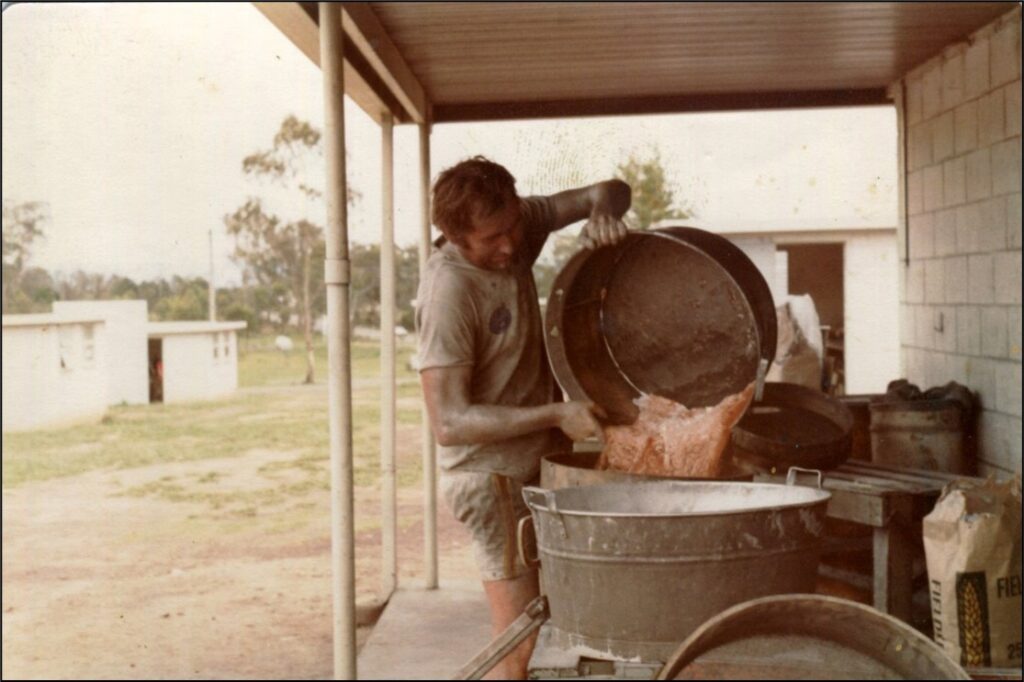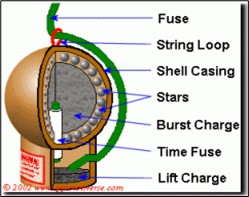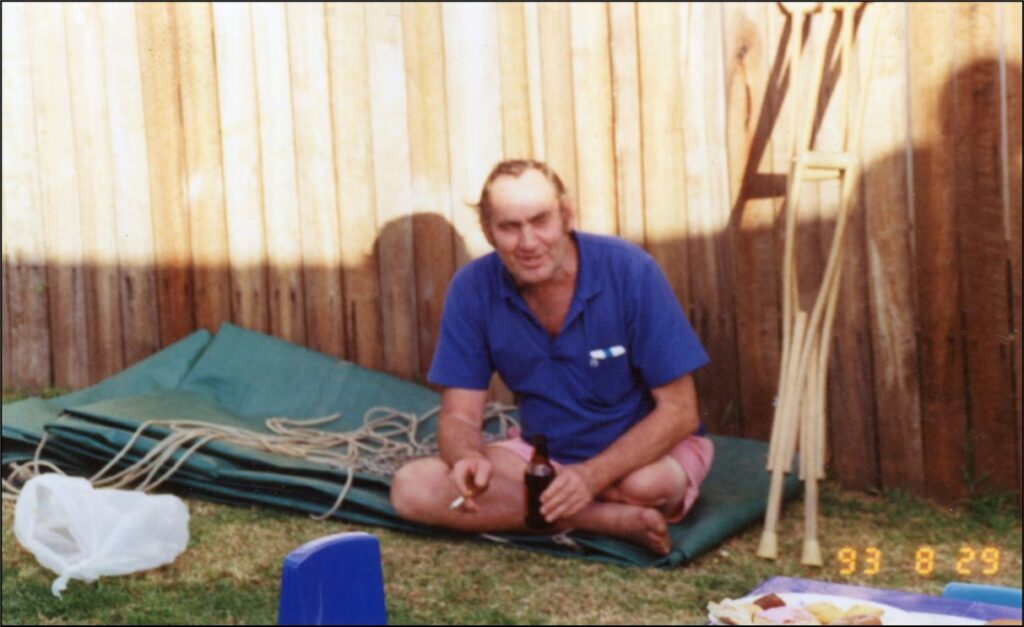by Heather Smith
Jeffrey Clive Skinner was born on 14th September 1939 at Manly District hospital. The youngest of 5 children to Alexander and Gladys Amelia Skinner.
Jeff’s career as a young boy in Manly was anything but promising. Waggin’ school soon bought him to the notice of the Truant Inspector. He was a pupil at Balgowlah Public school when he managed to truant school for three months before the Education Department caught up with him. He was moved to Harbord Opportunity school as a last ditch effort by family and the Department to straighten him out. Running with a pretty wild gang his criminal career came to an abrupt halt when an older boy in the group stole some money and bought seven air rifles and they graduated to shop break & enters. Finally the Police caught up with him and he was sent to Yasmar Boys home.
He recalls his father was a hard but fair man but his Mother meted out the punishment with a leather strap. On his release from Yasmar Jeffrey now 16 years old embarked on a career of unusual jobs but none would prepare him for the unique job that would eventually take over his life.
Jeffrey has never been afraid of work even as a school boy waggin’ school, and living near Balgowlah Golf club he did odd jobs helping the course designer on the upkeep of the greens. Using his initiative he would pick up any loose or unclaimed golf balls in the creek behind the 4th bunker, wash them and sell them back to the golfers for 6d (5c) each. This career was so successful that he was eventually banned from all local golf courses in the area.
No longer allowed to pursue his golf ball recycling business he turned to “spriggin” at Manly Warringah Bowling club. This back breaking job was to use a 3-pronged tyne fork punching it into the green to aerate the soil and allow water to penetrate to the grass roots.
Finally in 1959 at 20 years Jeff married a local Manly girl Maureen the love of his life and they became the parents of three children. Two boys, Lance and Jai, and his daughter Tania. In the meantime his brother Robert Henry moved to Riverstone for work and in early 1960 Jeff came up for a visit. Naturally they visited the local hotel for a beer and it was in the pub he was offered a good but complicated deal to purchase a property in the area. The problem was the present owner still owed money to the previous owner. Finally when the deal was sorted Jeff was the owner of two old houses on three acres of land in Terry Road for a cost of eleven hundred pounds ($2200).
Jeff paid cash for the sale and immediately rented out the two houses. A year or two later he and his family decided to move into one of the houses and he was soon involved in another recycling career.
He invested in an old utility and scoured the district picking up scrap metal which he sold to a scrap dealer on Windsor Road, Vineyard. Seeking to expand his one man operation he acquired six ferrets and branched out into rabbit hunting. He sought rabbits far and wide – Sofala, Warragamba, Peak Hill and across the Hawkesbury area. He would catch, skin and sell the meat, however he was unable to dispose of the pelts. Inquiries with Akubra who used pelts in the manufacture of felt for their famous Australian hats would only accept the skins in 15lb (7 kilo) lots and Jeff and his ferrets were not able to keep up this supply. Once again he embarked on his golf ball recycling business, he and his mate Alfie became a familiar site scouring the fences around local golf courses.
Like a true Aussie entrepreneur Jeff’s business was conducted in the local pub. Cecil Thacker the caretaker of Howard & Sons Fireworks Co., Box Hill NSW approached him with the offer of a job in the factory making railway detonators. Now known as Railway Track Signals (RTS) detonators were manufactured exclusively by Howard & Sons Pyrotechnics (Manufacturing) Pty. Ltd. They are used as a safety and signalling device by railway organisations to alert both drivers and others working on or near rail lines of an approaching rail vehicle or other hazard.
Each day Jeff made 120×72 trays of detonators placing small amounts of black powder into a moulded weatherproof 50mm steel base each base was then placed into a wooden “bra” tray and shifted into the drying room. When drying was complete as a further security measure a metal clip held the lid fast and a wire clip added to attach to rail track the entire detonator was dipped in paint and packed into boxes of 12 for transport.
When Old Nick (the only name he was ever known by) decided to retire from Howard & Sons (Manufacturing) Pty Ltd, Les Howard, who was in charge of manufacturing fireworks came to Jeff and informed him that he had one week to learn the job.
In retrospect the job Jeff had to learn was very dangerous. He had very little education and no training in any type of chemistry or physics. He was mixing highly volatile black powder with chemicals using a recipe handed down through three (3) generations of Howard family. Hand written in a little black book and translated each day by Les Howard who was dyslexic. The abbreviated version of each chemical was written on the shed wall and wiped out at the end of the day.

Howard & Sons became famous worldwide when they secured a contract with Disneyland and Disneyworld USA to supply hundreds of six inch plume silver and mauve aerial shells for their nightly fireworks display. China conceived fireworks in 9th century, hundreds of years later Italy perfected the aerial shell. Projected into the sky from a mortar culminating in brilliant burst of coloured stars. Each company had their own jealously guarded secret recipes for the coloured stars and Howard & Sons were no exception.
The basic construction of aerial shells has never changed since first introduced by the Italians however once detonation was by a hand held device (port fires) they are now literally blown into the sky by computers. Jeff remembers clearly the primitive mixing of the compound making coloured stars. Ingredients were loaded into a cement mixer and as it turned the mix gradually changed into small balls which were turned onto a wire rack to dry.
The stars, bursting charge and fuses were packed into each half, sealed to form a round ball the lifting charge was attached to the base. The entire shell was covered in brown paper and ready to pack for the next display.

For some forty years Jeff held secrets which overseas pyrotechnicians would have loved to have known, however he never revealed to anyone the secret of the mixes he learnt from the late Les Howard.
Jeffrey’s ability to overcome physical and mental setbacks would have stopped a lesser person in their track. A young man when he lost his leg he has been a familiar figure around Riverstone for some 50 years. Walking with the aid of one crutch he has never let it stop him from working, driving, ferreting and fishing. However the loss recently of his wife Maureen has been the final blow to Jeff., now confined to a wheel chair and after spending time talking to him you can still see that his mind is sharp as a tack and I am sure there is some plot hatching in the back of his brain for a new “re-cycling” scheme.

Photos courtesy of the Skinner family
